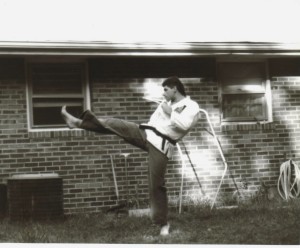A teacher by any other name…
 The world of martial arts can be egotistical, pretentious and disingenuous. In America we judge according to styles, rank, or association yet often we ignore some of the most important inspirations that have added to our journey. It is too easy to dismiss the skill and knowledge that can be afforded us from unlikely sources. Many skilled martial artists have been laid out by a brawler with some good fighting sense and ability to absorb and deliver punishment. Sometimes we learn more from applying our skills against a realistic adversary than we can in the controlled environment of a school.
The world of martial arts can be egotistical, pretentious and disingenuous. In America we judge according to styles, rank, or association yet often we ignore some of the most important inspirations that have added to our journey. It is too easy to dismiss the skill and knowledge that can be afforded us from unlikely sources. Many skilled martial artists have been laid out by a brawler with some good fighting sense and ability to absorb and deliver punishment. Sometimes we learn more from applying our skills against a realistic adversary than we can in the controlled environment of a school.
Growing up in my home wasn’t exactly stable and, at times volatile. We were imparted with ideas of strength, tenacity, accountability and responsibility, but family structure habitual discipline were lacking. My parents gradually grew apart, and once we hit our adolescent years, the environment had become toxic. Of the four brothers, my older brother Ed and I were the youngest and as things deteriorated it affected us and as we got older we both turned to very different martial arts.
We had all lifted weights, and did sports to some degree, although I was the least interested and committed. My brother Ed, always had a clear set of principles, a code, and drove his training by channeling his anger and frustrations that he felt due to insults or injustices. This proved to be quite effective. At 6’1″ and 225 lbs, he was lean, very strong, and a very aggressive fighter. Combining training of boxing, Tang Soo Do and his extensive knowledge of wrestling, he became a formidable adversary. Over the years he would become a martial arts gypsy, studying for a couple years in traditional Korean styles, American Goju, Nisei Goju, and Aikido, sometimes leaving a school due to geography, scheduling or curiosity into another discipline. In my more than three decades of martial arts training, I have rarely encountered many fighters with the ability, reflexes, power and ferocity my brother has shown. It was my experiences training and sparring with him that drove me to keep looking deeper and deeper into martial arts study. Through some brutal practice I found there had to be something more. he had a substantial physical advantage over me, in speed, strength, reflex and aggression, and I knew if I continued in that path I would always be limited to what my body was capable of, no matter how hard I pushed it. Over the years we had opportunities to train and spar with many friends and colleagues, and not once did Ed fail to gain the respect of those we trained with. More importantly the intensity with which he trained left an indelible mark. Once you worked out with him, you knew the meaning of hard.
In all these years he still trains with the same ferocity, whether in weight lifting, martial arts or studying nutrition. I am lucky to have someone who has been such a driving force in my training and he is always a wellspring of knowledge when I need insight on diet, injury rehabilitation, conditioning or weight lifting. I would not be where I am without this influence. He is truly a rock that I smashed against to make myself stronger. In the end we realize that very few of us will be remembered in our history and before long, just become an obscure footnote in someone else’s personal journey. History is cold and uncaring, so we must focus on the moment, and appreciate the teachers that come in all forms. My brother Ed has been my teacher every bit as much as Sifu Wilson and Master Ting, despite not being accredited to those levels. While many martial artists bask in the glory of a hard earned rank, in the end it dies with us, and we must realize that many of the greatest were not recognized in life and have passed into antiquity with little fanfare. Take the time to appreciate the sources of knowledge you have. Do not disregard those who contribute in less than typical ways. My brother hasn’t carried a grandiose rank or a Ph.D in weight lifting or nutrition but he has accumulated vast knowledge that he has been willing to share. We all have those who have taught us and therefore are our Sifu, Sensei, Sa Bum Nim, and should be recognized in our hearts. I hope everyone is as lucky to have teachers like Sifu Wilson, Master Ting, and my brother Ed.